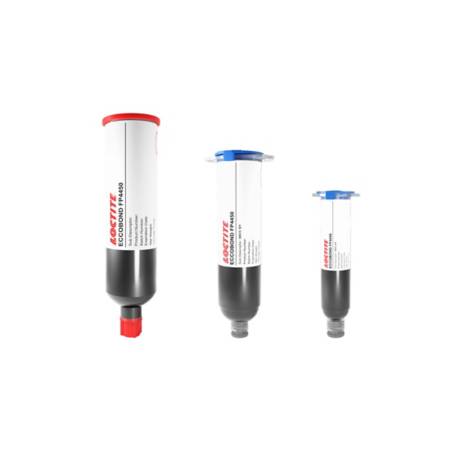LOCTITE ECCOBOND FP4450
Harmonization Code : 3907.30.00.90 | Polyacetals, other polyethers and epoxide resins, in primary forms; polycarbonates, alkyd resins, polyallyl esters and other polyesters, in primary forms : Epoxide resins : Other
Main features
- Fill Encapsulant
- High purity
- Good moisture resistance
Product Description
LOCTITE® ECCOBOND FP4450 Fill encapsulant is designed for protection of bare semiconductor devices. It offers great chemical resistance and pressure pot performance on live devices up to 500 hours with no failures, depending upon the device and package type. A cavity or potting dam is required for flow control.
LOCTITE® ECCOBOND FP4450 is the standard, tried and proven oven cure product with high reliability and hundreds of customers using it. It has lower flow then the FP4450HF (120 vs 25um max filler size) but it does the job great and with a much lower price.
Recommended Cure Schedule- 30 minutes @ 125°C plus
- 90 minutes @ 165°C
Technical Specifications
| General Properties | |||||||||
| Filler Content | 73 % | ||||||||
| Pot Life Pot Life Pot life is the amount of time it takes for the viscosity of a material to double (or quadruple for lower viscosity materials) in room temperature after a material is mixed. It is closely related to work life but it is not application dependent, less precise and more of a general indication of how fast a system is going to cure. | 72 hours | ||||||||
| Specific Gravity Specific Gravity Specific gravity (SG) is the ratio of the density of a substance to the density of a reference substance; equivalently, it is the ratio of the mass of a substance to the mass of a reference substance for the same given volume. For liquids, the reference substance is almost always water (1), while for gases, it is air (1.18) at room temperature. Specific gravity is unitless. | 1.77 | ||||||||
| |||||||||
| Physical Properties | |||||||||
| Viscosity Viscosity Viscosity is a measurement of a fluid’s resistance to flow. Viscosity is commonly measured in centiPoise (cP). One cP is defined as the viscosity of water and all other viscosities are derived from this base. MPa is another common unit with a 1:1 conversion to cP. A product like honey would have a much higher viscosity -around 10,000 cPs- compared to water. As a result, honey would flow much slower out of a tipped glass than water would. The viscosity of a material can be decreased with an increase in temperature in order to better suit an application | 43,900 mPa.s | ||||||||
| Chemical Properties | |||||||||
| |||||||||
| Water Absorption | 0.8 % | ||||||||
| Thermal Properties | |||||||||
| |||||||||
| |||||||||
| Glass Transition Temperature (Tg) Glass Transition Temperature (Tg) The glass transition temperature for organic adhesives is a temperature region where the polymers change from glassy and brittle to soft and rubbery. Increasing the temperature further continues the softening process as the viscosity drops too. Temperatures between the glass transition temperature and below the decomposition point of the adhesive are the best region for bonding. The glass-transition temperature Tg of a material characterizes the range of temperatures over which this glass transition occurs. | 155 °C | ||||||||
| Specific Heat Capacity Specific Heat Capacity Specific heat capacity is the amount of heat energy required to raise the temperature of a substance per unit of mass. The specific heat capacity of a material is a physical property. It is also an example of an extensive property since its value is proportional to the size of the system being examined. | 1105 J/(g⋅°C) | ||||||||
| Thermal Conductivity Thermal Conductivity Thermal conductivity describes the ability of a material to conduct heat. It is required by power packages in order to dissipate heat and maintain stable electrical performance. Thermal conductivity units are [W/(m K)] in the SI system and [Btu/(hr ft °F)] in the Imperial system. | 0.63 W/m.K | ||||||||
| Other Properties | |||||||||
| MSL Level | MSL 3 | ||||||||



